Entries in shadow flicker (12)
3/3/10 TRIPLE FEATURE: Brown County Board takes wind turbine related health concerns seriously AND The wind industry says if you would only admit your turbine problems are all in your head you could do something about them. AND More turbines, more problems.
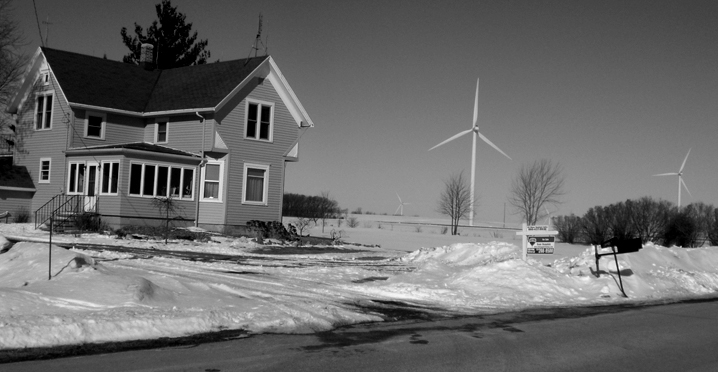 Home for sale, Fond du Lac County, WI February 2010
Home for sale, Fond du Lac County, WI February 2010
BROWN COUNTY TO STUDY WIND FARMS' IMPACT
SOURCE: Greenbay Press-Gazette
By Tony Walter
March 3, 2010
A Brown County Board committee voted Tuesday to form a special committee to gather information about the health, safety and economic impact of wind turbines on county residents.
A Chicago-based developer is seeking state approval to build the first major commercial wind farm in Brown County, a project that would put 100 wind turbines in the towns of Morrison, Holland, Wrightstown and Glenmore.
The issue came to a head Tuesday because wind turbine opponents said there is evidence that they could interfere with emergency radio communications. But several of the approximately 50 wind farm opponents who attended the meeting said they are as concerned for health reasons.
“This whole thing is being jammed down our throats,” said Marilyn Nies of Greenleaf, whose 5-year-old daughter has a heart disease. Some wind turbine opponents say the turbines can cause a variety of health issues that could affect people like her daughter. “Is it going to hurt us to wait a year or two so real studies can be accomplished?”
Carl Johnson of Greenleaf said the turbines add the turbines will bring low frequency noise, which he called “a new type of pollution.”
Steve Deslauriers of Greenleaf urged the committee to consider a wind diversion ordinance.
“The county’s voice needs to be heard,” he said.
Carl Kuehne of Ledgeview cited university studies in Spain, Germany and Denmark that he said showed wind turbines to be “total, complete and utter failures” in those countries. He said other studies have shown property values decreased 25-40 percent on property adjacent to wind farms.
He asked the committee to recommend a moratorium on wind turbines until a thorough investigation can be completed.
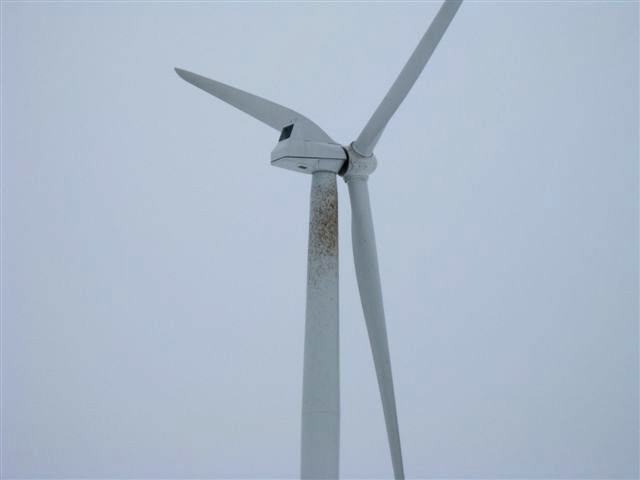 Oil splatters on a Fond du Lac County wind turbine, February 2010
Oil splatters on a Fond du Lac County wind turbine, February 2010
SECOND FEATURE:
The following commentary comes to Better Plan from a resident living in a Fond du Lac County wind project who wishes to remain anonymous.
You have an attitude problem.
That’s the wind industry’s latest explanation for the growing number of complaints from people living in industrial wind projects. They say, “You people just don’t like these things.”
The implication is that if you just changed your attitude, the problems you're having with turbine noise, sleep disruption, shadow flicker, and homes that will not sell--- all of these problems will go away.
As a Wisconsin resident who has been living in a wind project for nearly two years, I have to ask what it is that the industry wants you to like? What is there to like about having your home surrounded by 400 foot wind turbines? I can’t think of a thing …
-Unless you like constant audible and low frequency noise, from whooshing and thumping to grinding mechanical noises and transformer hum.
-Unless you enjoy chronic sleep disruption and associated health problems for you and your family.
-Unless you enjoy signal interference on your radio, TV, and cell phone.
-Unless you want to live in an area where Flight for Life emergency transport helicopters can no longer land.
-Unless you enjoy the strobe flashing of turbine shadow flicker inside and outside of your home on sunny days and moonlit nights.
-Unless you are glad the birds and bats are gone along and other wildlife once so common before the turbines went up.
-Unless you think it’s beautiful to be surrounded by scores of red lights flashing in unison from the turbines at night, or regard leaking oil on the towers and land below as decorative.
-Unless you want to live in a place where wind developers pitted neighbor against neighbor and tore the community apart in a way that will never be repaired.
-Unless you appreciate your peace of mind and family relationships disintegrating because of the stress of no sleep and uncertainty about being able to sell your house, because you’ve seen how the houses in your project just sit with no buyers, because you know how few people want to buy a home so near turbines and you can’t blame them—because you wouldn’t want to live so close to wind turbines either.
Except, now, of course, you do.
This new “blame the victim” PR move underscores the wind industry's own attitude problem, one of insensitivity and an inability to understand and be compassionate toward the people whose problems began only after the wind turbines went up.
NOTE FROM THE BPWI RESEARCH NERD:
There have been a number of reasons why residents of wind projects in our state have asked for anonymity when contacting Better Plan. Some have family members who work for companies associated with construction of the turbines. Some have family members or neighbors who are hosting turbines. Some are hosting turbines themselves and regretting it, but are fearful of being sued by the wind company for violating the gag order in their contract.
Better Plan is glad to insure anonymity to any wind project resident who contacts us, but we always confirm the identity of anyone who submits material for us to post.
We'd like to thank the family who sent us this commentary.
THIRD FEATURE
Wind turbines stir up controversy in Brown County
SOURCE: WFRV-TV Channel 5 News
BROWN COUNTY (WFRV) – Some Brown County residents say they’re worried about plans to put a 100 turbine wind farm in southern Brown County.
Invenergy wants to build 400-foot wind turbines on 72-square miles of land.
Residents enumerated a host of issues they have with the build at a Brown County Committee meeting Tuesday evening.
Home owners say they're worried about well contamination, noise pollution and potential unseen health issues. A concerned parent speaking from the podium at Tuesday’s meeting said she’s worried the project could worsen her 5-year-old’s heart condition. She wants to delay the project a year or two for a comprehensive study. “I feel like this whole thing is being jammed down our throats.”
Steve Deslauriers, a Town of Morrison firefighter, says he’s worried 9-1-1 calls could be interrupted by the wind turbine’s blades. “If it impacts even one accident scene, it’s one too many” Deslauries tells Channel 5’s Jenna Sachs.
Deslauriers also says he’s worried history shows rescue choppers might not fly near the turbines. “We can look to Fond du Lac County as a guide for how flight rescue would be handled” Deslauriers says. “There they will not fly into a wind farm at night or into a cluster of wind turbines.”
Sachs spoke with representatives from Invenergy and Brown County Public Safety about the 9-1-1 issue. Both parties say they can work together to make sure 9-1-1 signals aren’t interrupted, since the new radio towers haven’t been built yet.
2/25/10 Wind Project Picture of the day AND Knock Knock. Who's there? It's the same We Energies representative you've already said no to three times this week AND What about that meeting in Brown County?
 Home in a Wisconsin wind project. Fond du Lac County 2009
Home in a Wisconsin wind project. Fond du Lac County 2009
Construction of Wisconsin's largest wind farm put on hold as WEPCO struggles to find willing landowners: use of eminent domain may be only option.
A resident in Columbia county has contacted Better Plan to say We Energies representatives are scrambling to find enough landowners willing to sign the easements needed to begin construction on the Glacier Hills wind project which is set to occupy the Columbia County Towns of Randolph and Scott. The 90 turbine project which was recently approved by the Public Service Commission, would be the largest in the state.
We Energies representatives are reportedly offering residents a signing bonus of $5000 for completion of contract paperwork by February 28th. The contracts offer landowners a yearly payment of $2,000 with a 2% annual increase. Residents report these numbers can vary widely depending on the importance of a particular easement to the project.
The easements would give We Energies permission to create turbine noise that will exceed the limits set for homes by the PSC. The easements would also allow such things as trenching for laying cables and transmission lines needed to connect the turbines along with other rights We Energies may need. The duration of a contract of this sort is usually a minimum of 40 years and runs with the land.
Some residents who have refused to sign contracts say they are still being hounded by We Energies representatives who won’t take no for an answer.
“They’ve tried to make contact with me three times already in the last several days” says Kristine Novak, whose home would be inside of the project. “They are going house to house.”
We Energies representatives may not find a lot of welcoming faces in a sharply divded community still reeling from the PSC’s decision to approve the project.
“I guess the best way to describe the feeling in the area is shock,” said the resident who wished to remain anonymous. “Hard feelings that developed earlier have now become worse.”
Those hard feelings may well extend to the We Energies Representatives who are now desperate to make deals. Says the resident, “Landowners are telling them to ‘get the hell off my property.”
He believes the tension in the community is so high that should We Energies decide to force the project through by use of eminent domain the consequences would be serious. “People around here will only take so much,” he said.
Better Plan invites residents affected by the Glacier Hills wind project to contact us with their stories.
We hope reporters in our state will follow up on this news-tip and find out more.
SECOND FEATURE:
Public Airs Concerns and Support at Wind Energy Meeting
Feb 19, 2010A Chicago company wants to build wind turbines on towers 400 feet tall in southern Brown County, using private land in Morrison, Hollandtown, Wrightstown, and Glenmore. If it's fully realized, it would become the largest wind farm in the state.
Those fighting the project held an informational meeting Thursday night, and hundreds showed up. Emotions ran high in the meeting.
"This is an industrial factory that's being dropped over some of the best farm land in Brown County," Sandra Johnson said.
"Wind is a good thing. I'm not against wind energy, we're just against the locations right now. We need to have some better setbacks and in a lot less-populated communities," David Vercauteren of Greenleaf said.
The Ledge Wind Energy Farm would be a 150-megawatt project with roughly 100 turbines.
Those backing it say it would give the county a big financial boost.
"This is a project that offers tremendous benefits in terms of new tax revenue to the county, helping farmers who were struggling, with jobs," Barnaby Dinges of Invenergy said.
Still, those who live nearby raised fears of stray voltage, shadow flicker, and noise issues.
Some say if it's built, they'll leave.
"If they go up as they're predicting, we very likely will move," Johnson said. "The problem is, land depreciates once you're in that turbine ghetto. People don't want to come. People aren't interested in buying it."
Right now the Wisconsin Public Service Commission is taking comments on the project. A public hearing will take place later this spring.
If approved, construction will likely start in 2011.
2/19/10 TRIPLE FEATURE: CORRECTION: We were wrong. It was MONROE county not Brown County AND When it comes to the ways of wind developers, the cat that lost its tongue found it on Thursday night in Brown County AND what does it take to come between a father and son? Would you guess a payment from a wind developer? AND Wisconsin wind farm residents are not alone in health complaints
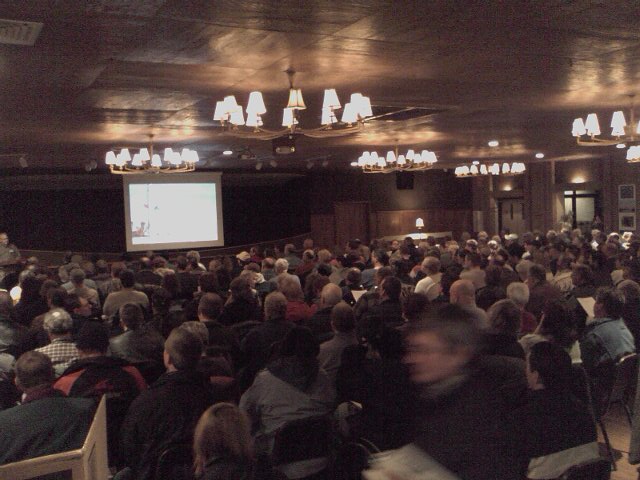 Concerns about proposed Invenergy project drew capacity crowd to Thursday's BCCRWE meeting
Concerns about proposed Invenergy project drew capacity crowd to Thursday's BCCRWE meeting
Correction: Better Plan was in error when reporting that residents who spoke out against the Invenergy project proposed for Brown County found dead skunks and deer heads on their mailboxes.
The dead skunks and deer heads were found on the mail boxes of those who spoke out against an Invenergy project in Monroe County
Better Plan regrets the error.
Concerns about proposed Invenergy wind project draws capacity crowd to meeting in Brown County
By Lynda Barry
February 20, 2010
KAUKANA- It was standing room only in Van Able's restaurant after residents quickly filled the five hundred seats in the banquet hall and overflowed into a side room.
Community members came to hear concerns about Chicago-based Invenergy's 100 turbine Ledge Wind project which would occupy the Towns of Morrison, Holland, Wrightstown and Glenmore, making it the largest wind development in the state.
The event was organized by a grassroots community organization called Brown County Citizens for Responsible Wind Energy (bccrwe.com) and drew a capacity crowd.
Along with speakers who addressed the now well-known issues of turbine noise, sleep loss, shadow flicker, loss of property value and impacts on farm animals, local residents had the chance to hear about something rarely spoken about in public.
Landowners detailed their first hand experiences with the questionable techniques used by Invenergy to convince them to sign onto the project.
They spoke about being lied to by developers who said their neighbors had signed onto the project when in fact they had not. They spoke about the varying amounts of money offered to different landowners even as Invenergy claimed publicly that all landowners were getting the same amount.
Some landowners talked about about what made them decide not to sign on to the project while others expressed deep regrets about having signed the contracts.
There were several discussions about what options landowners had for getting out of contracts and along with concerns about being sued by the wind company.
Speakers also talked about about the negative impact the proposal has had on the community and spoke about the new hostilities between neighbors and family members.
A speaker from Monroe county mentioned that in his community residents who spoke publicly against the project were soon greeted by dead skunks and deer heads on their mailboxes. Some felt the wounds made to this previously strong community would never heal.
Invenergy representatives were in attendance but did not openly identify themselves and remained quiet throughout the meeting.
More on this story to come.
SECOND FEATURE
Wind farm debate divides families
WBAY-TV, www.wbay.com
by Jeff Alexander
February 17 2010
Plans to build the state’s largest wind farm in southern Brown County is dividing several rural communities. It’s even causing turmoil within families.
For almost a year now, Roland Klug has lobbied his neighbors to join him in signing contracts with a Chicago company to build 400-foot wind turbines on their land in Morrison. As Roland sees it, it’s a sign of the times.
“Some people hate them. I love them. I think it’s progressive. It’s a country moving forward,” Roland said.
But just a mile away is another sign with a very different message put up by Roland’s son, Dave.
Like many families in this farming country, the Klugs are at odds with each other.
“It is very, very trying I will say right now,” Dave said.
As Dave sees it, the prospect of 100 turbines towering over the landscape is appalling. The fact that four could be as close as 1,000 feet from his home is scary, he says.
He points to research he says he’s done on other wind farm developments around the country and the impact on nearby residents.
“Every one we read about are having all kinds of health issues, property values drop, and to me I guess it just doesn’t seem like it’s a real good investment for our community,” Dave said.
But according to Roland, it’s an investment that will help him keep his farm. He’s signed on for two turbines that will pay him $20,000 a year.
Roland says he “had to sell off 48 acres to make a payment for a couple of years, and we’d have to just keep selling off.”
Roland knows he’s made some neighbors angry. “My son gets very mad.”
Dave said, “My son is 21 and was all set to buy some land right by me which would’ve been my dream, been great, but right now we had to put it all on hold. You cross your fingers, but he’s probably going to end up living somewhere else.”
Roland says, “I just know in time it’ll all straighten out, it always does.”
Dave Klug, though, isn’t so sure. Especially if the wind turbines go in.
There is a meeting scheduled for Thursday night called “Living in an Industrial Wind Turbine Project.”
It’s at Van Abel’s in the Town of Holland. Doors open at 6 P.M. and speakers begin at 7.
NEW! CLICK HERE to watch a video about wind farm residents in Australia who describe sleep loss, health problems and other complaints identical to those reported by Wisconsin wind farm residents.
For those with slower internet connections CLICK HERE to read the transcript of the interview
NOTE FROM THE BPWI RESEARCH NERD: People who live in Rock County may be interested in the wind company's response to resident's complaints. Spanish owned Acciona is the same company that now owns the leases to land in the Towns of Magnolia and Union. Better Plan, Wisconsin has contacted Acciona several times to ask about their plans for the community. Acciona has not replied.
 WANT MORE? CLICK HERE TO READ TODAY'S "WIND TURBINES IN THE NEWS"
WANT MORE? CLICK HERE TO READ TODAY'S "WIND TURBINES IN THE NEWS"
9/6/09 What's all the noise about wind turbine noise?
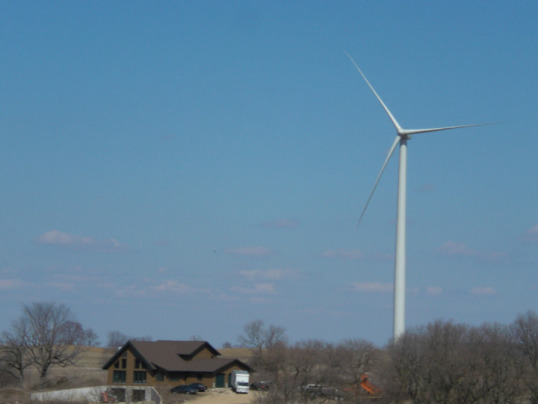 Home in Butler Ridge wind farm, near Iron Ridge, Wisconsin 2009
Home in Butler Ridge wind farm, near Iron Ridge, Wisconsin 2009
What's all the noise about wind turbine noise?
By Lynda Barry
"There can be no doubt that groups of industrial wind turbines ("wind farms") generate sufficient noise to disturb the sleep and impair the health of those living nearby," states Dr. Christopher Hanning in a recent report titled "Sleep Disturbance and Wind Turbine Noise." [Click here to download full report]
For those of us who have stood directly beneath an industrial wind turbine on a clear afternoon, this statement will come as a surprise. What noise could Dr. Hanning be referring to? The only noise most of us hear at the base of a turbine is the swooshing of the blades above us.
Life in an industrial wind farm is something very few of us have experienced. Most of us don’t know that the quietest place near a turbine is directly beneath it. It’s a bit like standing beneath a speaker placed 40 stories above you. Step out about 1000 feet downwind from the turbine and you will have a different experience, especially after sundown. Though we may not know the physics behind the phenomenon, most us notice sound carries further at night, especially in open rural areas. This turns out to be especially true for wind turbine noise. The noise Dr. Hanning writes about is nighttime turbine noise.
Interestingly, very few (if any) of those responsible for creating the setback distances and turbine noise limits have spent any nights in homes near wind turbines. Nor have they sat through an hour of severe shadow flicker inside of a home.
Why should they? The modeling software used for siting virtual turbines near virtual homes assures them that they’ve gotten their calculations right. So if real people are having problems with real noise and real flashing shadows they must be making it all up.
But are they?
Daniel Haas, a Wisconsin wind farm resident who has been living with turbine noise for nearly two years put it this way in one of his many letters of complaint to the wind company. The setback from homes in this project is 1000 feet.
“I really do not know much about noise levels but what is the noise level of a commercial jet coming through the middle of your house at 2:00 in the morning?
I really am getting tired of the misinformation given to anyone with a complaint. There are different noise levels and you only talk about one.
The low level noise that I am concerned about is extremely loud and actually shakes the whole house. It wakes the whole family up at night. It also spooks our horses so bad that we can't even ride them on our trails anymore. Our dogs won't even come out of their kennel because they’re afraid of the noise.
As for the shadow flicker it is terrible. It affects all of my 100 acres. Yes all 100 acres. That is my home.”
In May of 2009, the Minnesota Department of Health issued a white paper that identified half a mile as the setback beyond which turbine noise and shadow flicker were not a major concern.
This setback is unacceptable to wind developers because it restricts the number of turbines they can profitably site in more populated rural areas which are also more likely to have the transmission lines they need nearby. Profits (and government subsidies) rely on being able to site the greatest number of turbines in the smallest amount of space. Their eyes are on a prize other than protecting the environment or protecting the health of those who will live inside of their wind farms. From a business standpoint this may make sense, but from a human standpoint it’s a formula for trouble.
Our legislature may also find safer setbacks unacceptable because our renewable energy mandates. Setbacks that are better for families mean fewer turbines for the state to make that goal. And though wind energy isn’t the only renewable energy choice, most consider wind to be the cheapest way of getting there, even if it means harming people in the process.
This is made much easier by a general misunderstanding about what the real problems are when wind turbines are sited too close to homes. How close is too close? If you go with a wind developers recommendations, 500 feet from your home is not considered too close. If you go with the National Academy of Sciences, the Congressional Research Service, The World Health Organization, the peer-reviewed study of wind farm residents by Dr. Nina Pierpoint, and Minnesota Department of Health, you’ll get a minimum setback of 2640 feet out to 1.5 miles.
The wind industry has not been able to provide any scientific or medical data which supports setbacks any closer than this, but they have been very good at dismissing and ridiculing those with complaints. For those of us who have witnessed well known instances of organized corporate denial of negative health effects caused by their product, this marginalization of wind farm residents who tell us their families are suffering raises red flags.
The general public knows very little about life in a wind farm. Most don’t know about the serious problems wind turbines cause when placed too close to our homes, or within ecologically sensitive areas such as migration corridors. For now, wind industry is enjoying its image of being a benign industrial-scale source of clean energy. Anyone who dares to challenge this Green Goliath should beware. The David who asks the hard questions about proper setbacks will be shouted down as an anti-wind, anti-environment, anti-green, NIMBY.
But the problem is not going away. As more families are forced to suffer because unsafe setbacks for the sake of wind industry profits and renewable energy deadlines, more Davids will appear. In the meantime, how many lives will be made miserable before we get this right?
In his report on turbine noise and sleep disturbance, Dr. Hanning finds current calculated measures of wind turbine noise “woefully inadequate” and says he is unconvinced by what he terms, "badly designed industry and government reports which seek to show there is no problem.
"Calculations cannot measure annoyance and sleep disturbance,” he writes, “Only humans can do so."
How close is too close? Wind farm residents now living in the wind farms in our state are trying to tell us,-- but right now, who’s listening?
10/4/09 Rock County Towns and wind developers: What to do until the PSC comes up with rules?
Wind developers have proposed 67 wind turbines for the Town of Magnolia, and have included the Town of Spring Valley in their target map.
The turbines will be at least 40 stories tall. The developers would like to site them as close as 1000 feet to non-participating homes. Five Rock County Towns have created ordinances with setbacks of at least 2640 feet. None of these ordinances has ever been challenged on their merits.
The developers who plan to put 67 turbines in the Town of Magnolia will not provide a map of where the turbines will be.
We made our own map, just to show what that many turbines would look like if they were distrubuted evenly across the township. Each orange dot equals one turbine. There are only 66 in this picture. We couldn't figure out where to put the 67th.
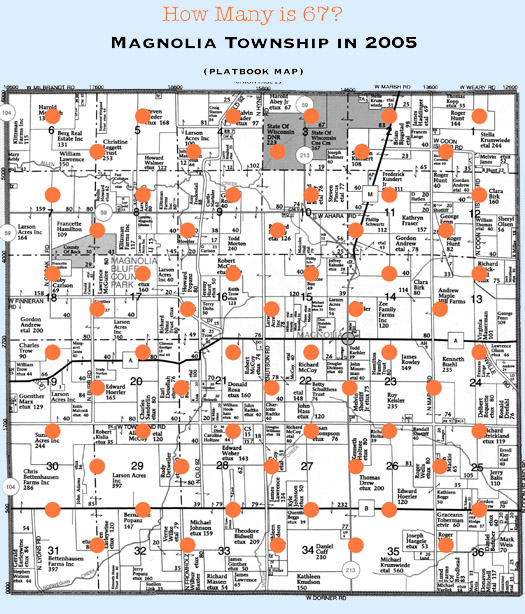
At present, the state of Wisconsin has just over 300 industrial sized wind turbines in operation. 14,000 more will need to be sited to meet the state's renewable energy goals.
Towns Plan for a new wind siting law
By GINA DUWE
3 October 2009
JANESVILLE — Officials in Union and Magnolia townships consider moratoriums on wind turbines to be the temporary answer in response to a new state law.
Wind developer EcoEnergy has proposed projects in both communities.
Local residents are concerned the new process on siting wind energy systems signed into law this week will erase their work to protect themselves from negative effects.
Moratorium action includes:
– Union Plan Commission last month recommended the town board start a one-year moratorium. On Thursday night, the town board approved the moratorium, which will expire on Oct. 7, 2010.
Union officials feel confident in their ordinance if it were challenged on its merits, but with uncertainties about the state writing new laws, “we just thought (the moratorium) was the prudent thing to do,” plan commission co-chair Doug Zweizig said.
– Magnolia Planning and Zoning will discuss and likely make a recommendation to the town board on a moratorium at its meeting at 7 p.m. Thursday. The town board will consider the moratorium at a meeting at 7 p.m. Tuesday, Oct. 13.
“We just really want to see where we stand with the state,” Magnolia town board member Dave Olsen said. “It seems as though they want to take the rights away to site the turbines, but they don’t want the responsibility that goes with it—to monitor the low-frequency sound, to look after the local residents.”
On Thursday, Gov. Jim Doyle signed into law Senate Bill 185, which puts the siting of wind projects under 100 megawatts into the hands of the Wisconsin Public Service Commission. Once the statewide siting rules are written, they will overturn local ordinances.
Projects 100 megawatts or more already go through the PSC.
PSC officials will appoint a committee to advise them on siting rules. No timeline has been established, a PSC spokeswoman said.
People suggested to Zweizig, the Union Plan Commission co-chair, that he should be on the committee, so he sent a letter of interest to the PSC and Doyle’s office. He hasn’t received a response.
The committee will comprise representatives of wind energy system developers, political subdivisions, the public, energy and environmental groups, realtors and land owners who live adjacent to or in the vicinity of wind energy systems and who have not receive compensation by or on behalf of owners, operators or developers of wind energy systems.
